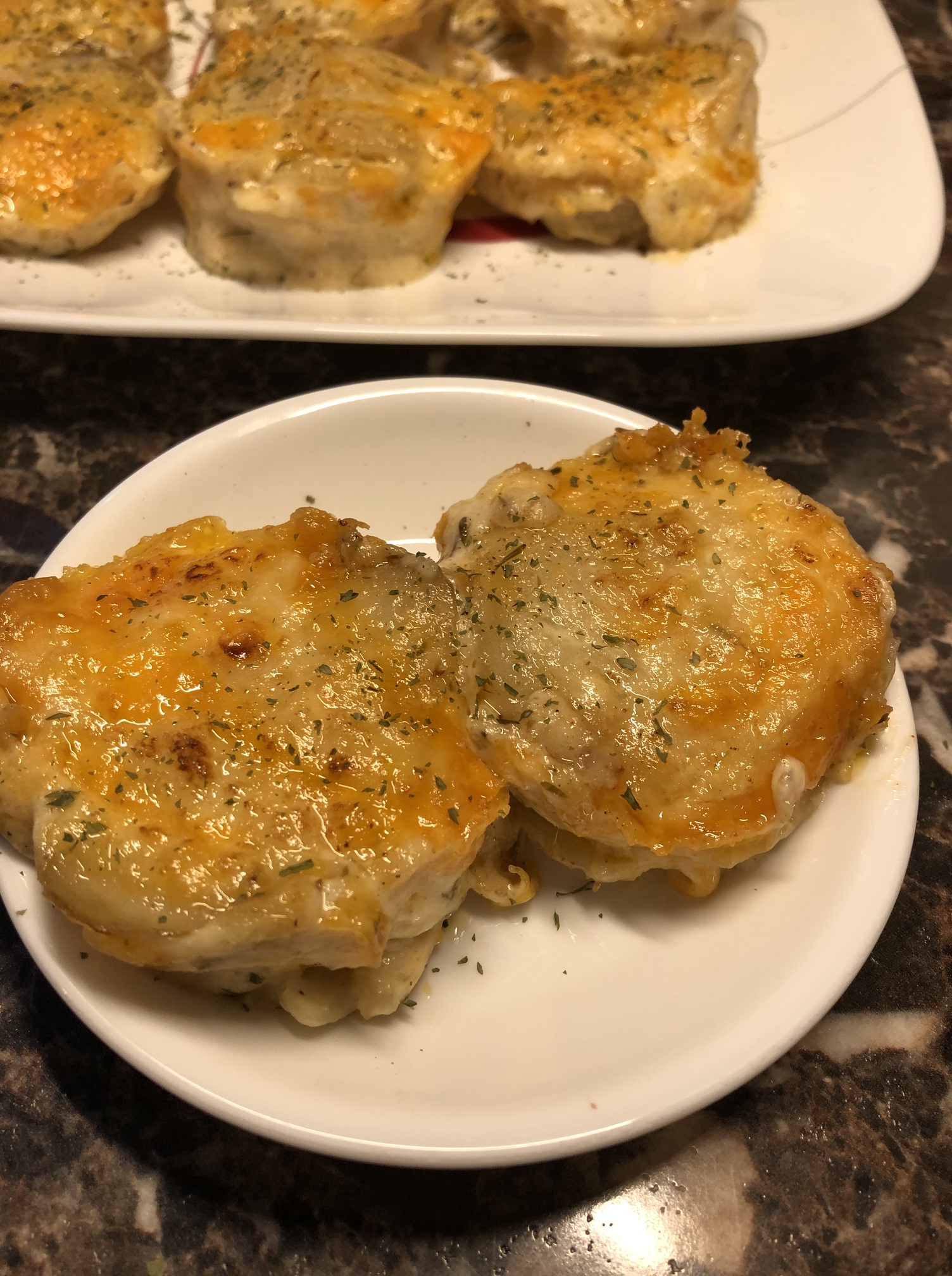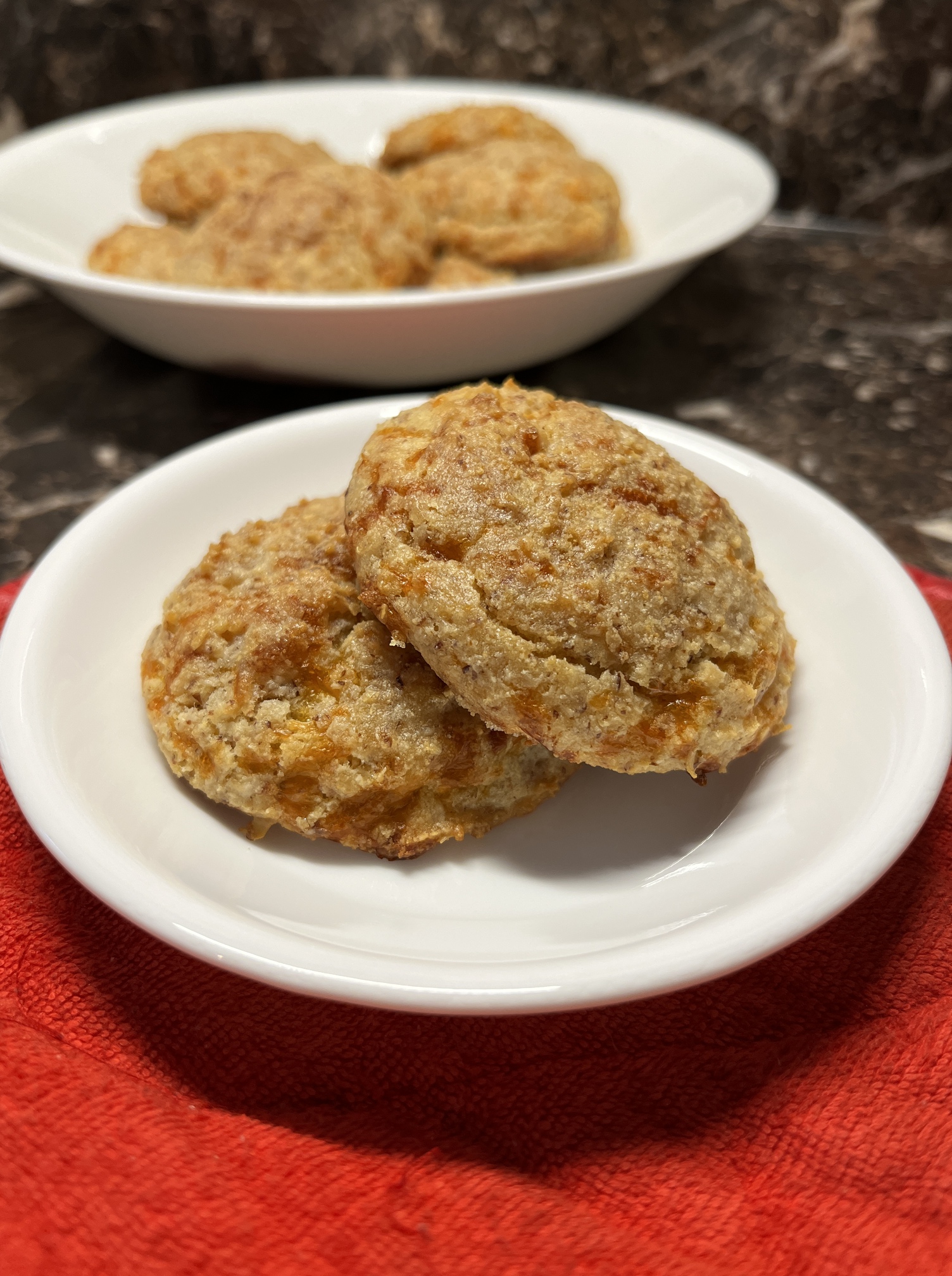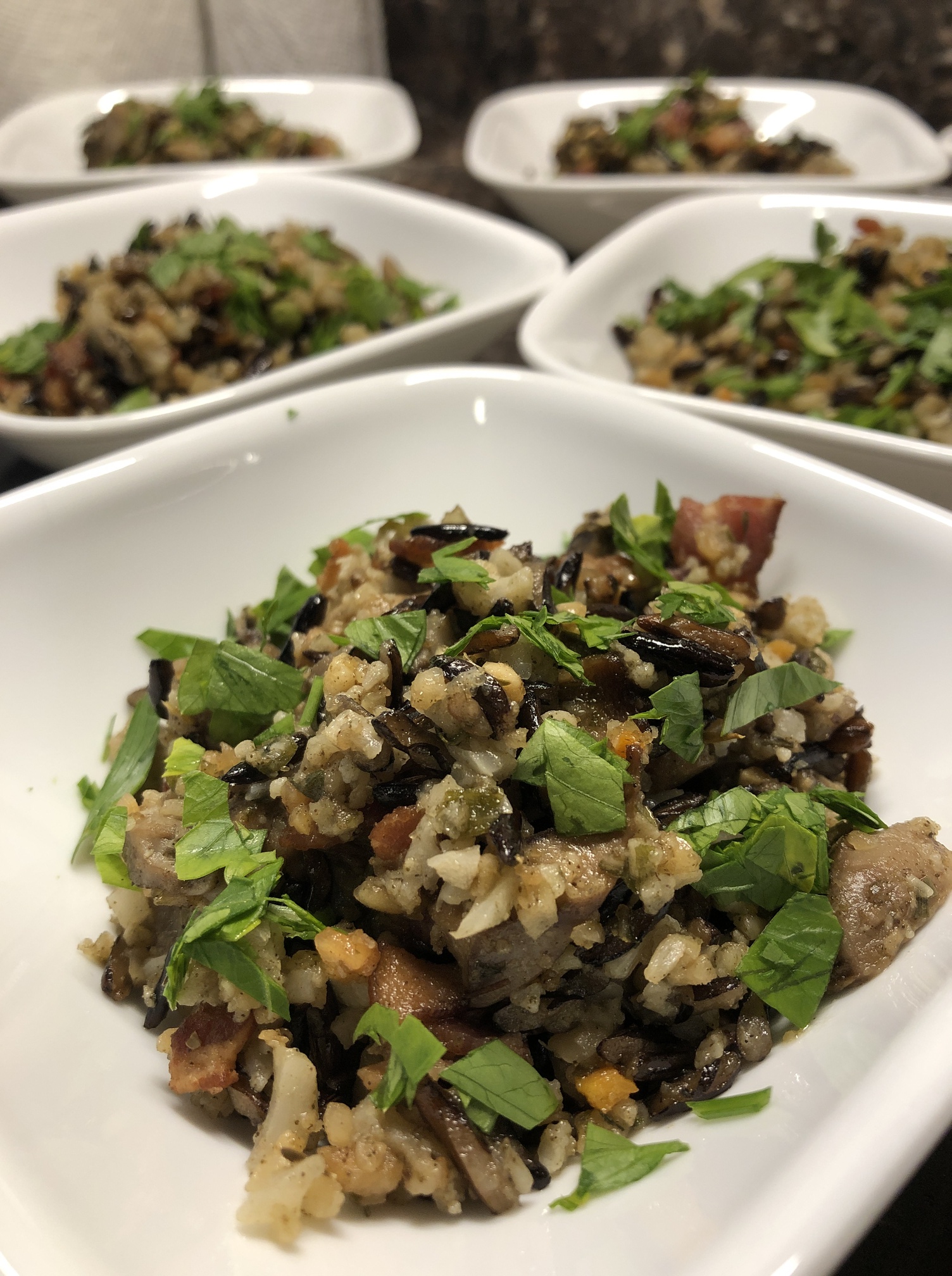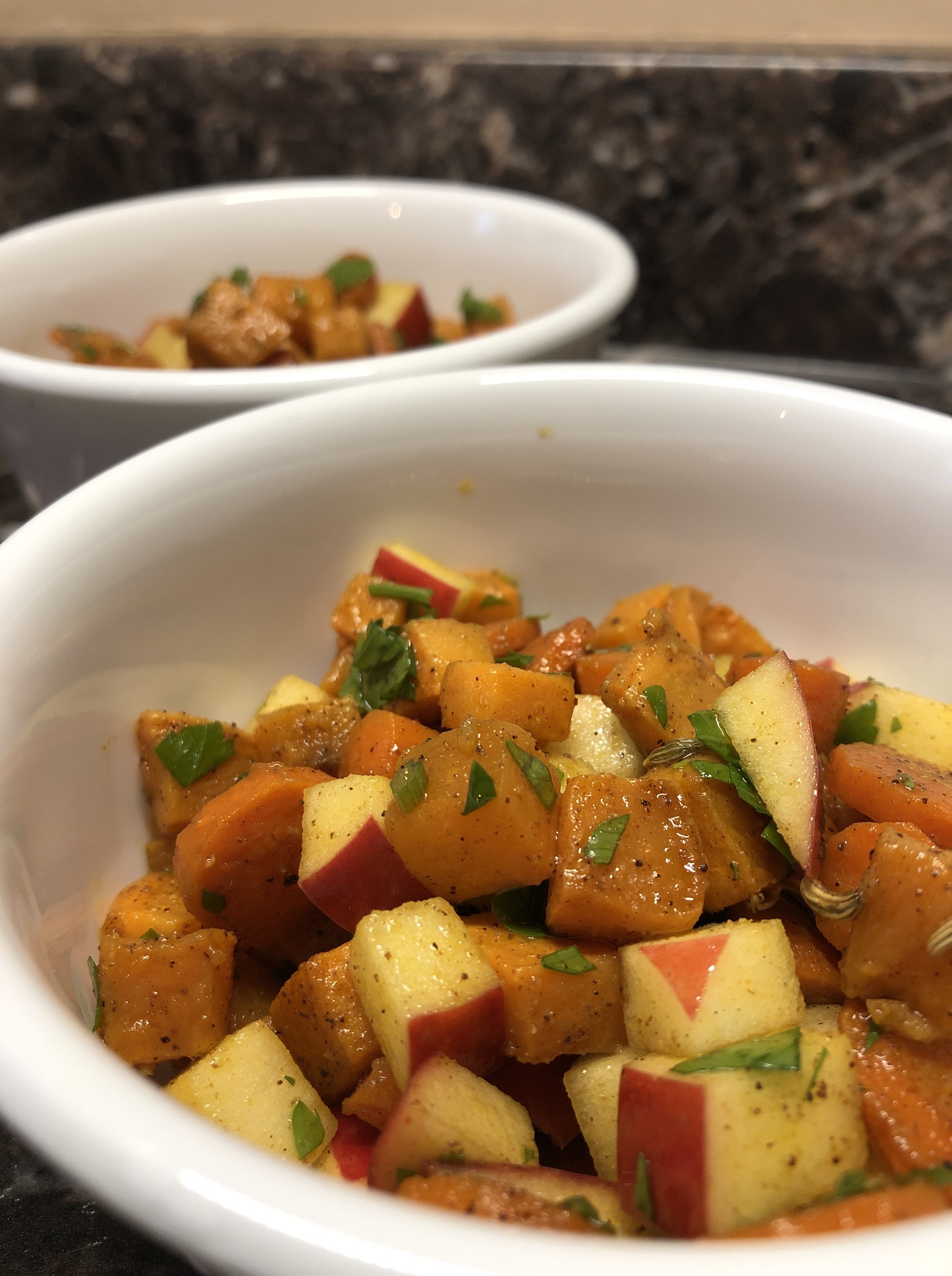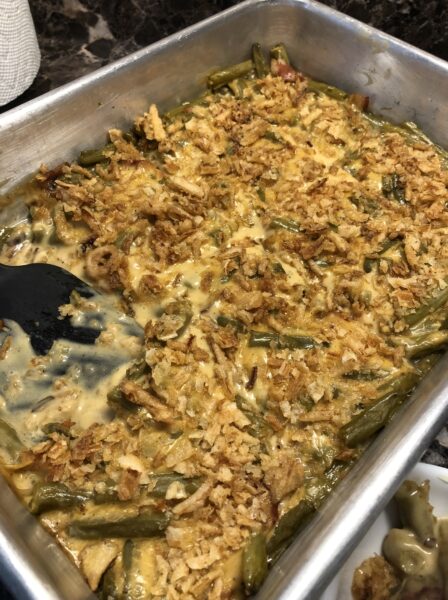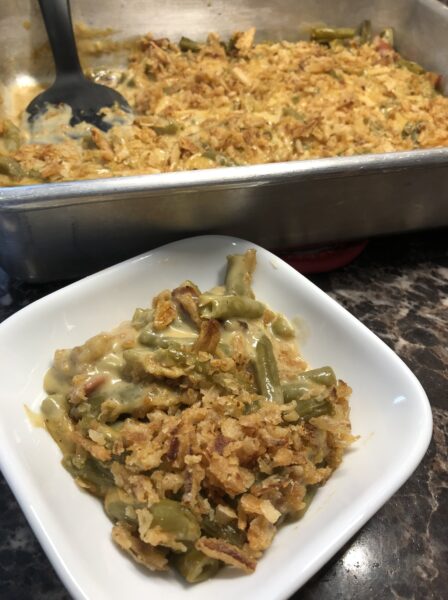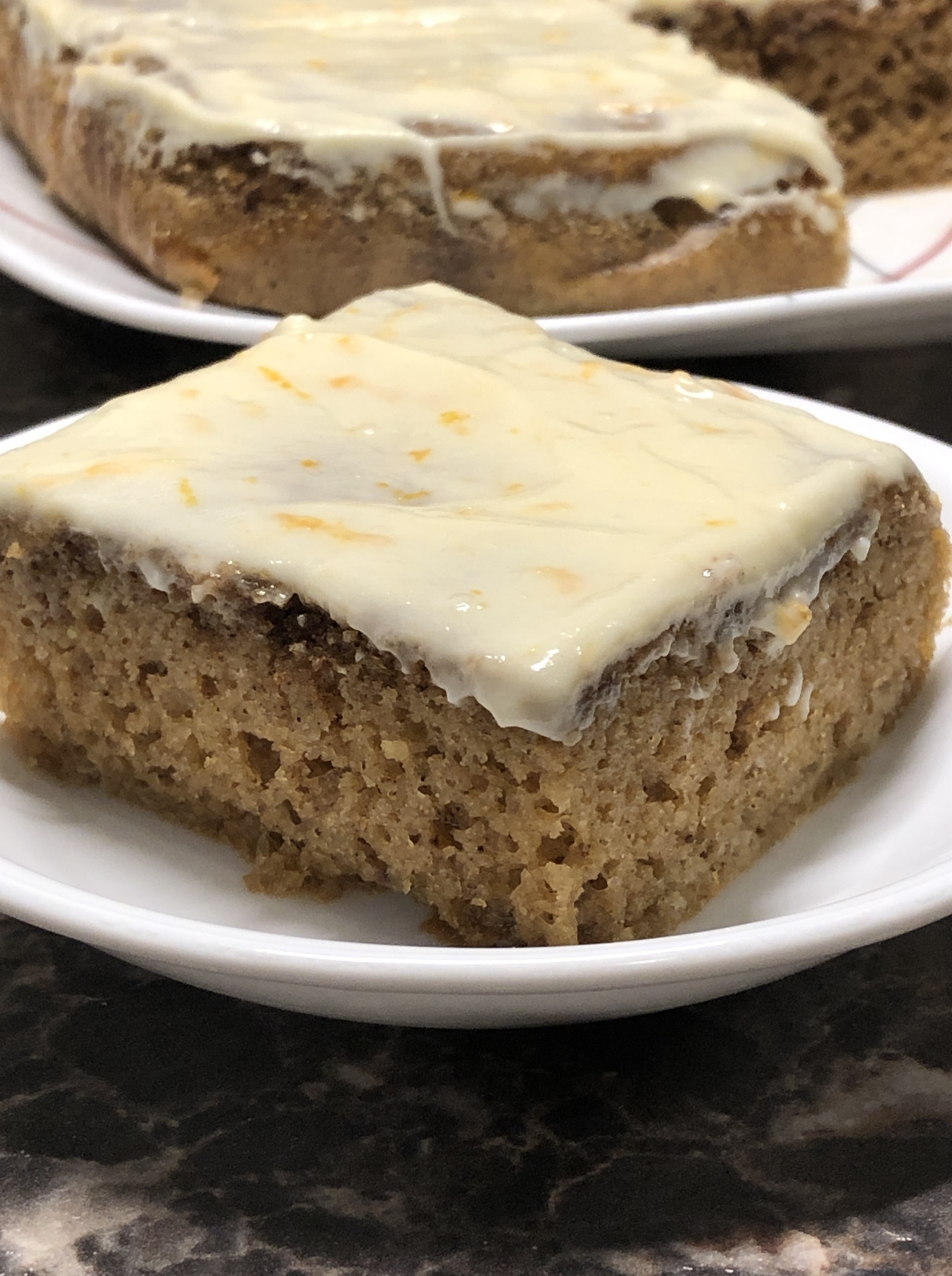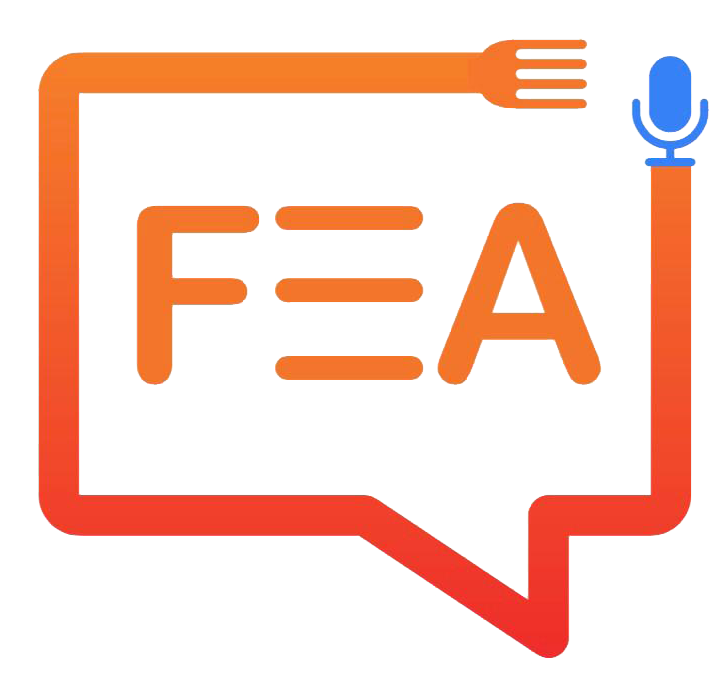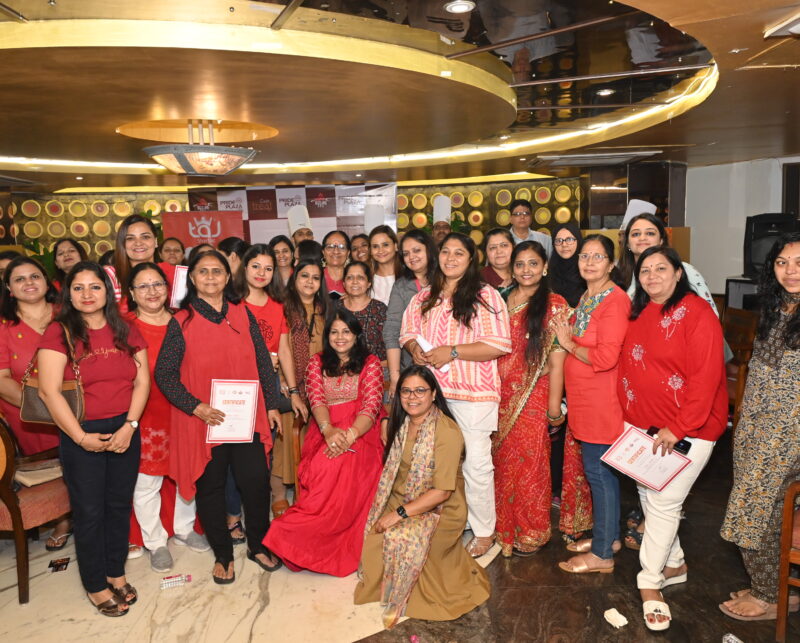COOKING FOR CHRONIC KIDNEY DISORDER PATIENTS
Linda Blaylock, CKD Culinary Consulting.
Article: Culinary Entrepreneurs Magazine
When my husband, Richard, was diagnosed and we started this journey, we did what most people do; we found
recipes online. Let me tell you, they were awful!
I tried desperately to season and improve them but wasn’t having much luck. My heart was breaking to see my
husband no longer enjoying meals and trying to surrender himself to accept his “fate”.
I couldn’t figure out CKD eating. I tried! Believe me, I tried! So, I focused on food. I enrolled in culinary school,
and more for nutrition. These two things opened my food world.
As I was finishing culinary school, they required an internship. I was amazingly fortunate to be accepted by
American Kidney Fund® who had just launched their Kidney Kitchen® website. They were looking for someone
like me to test and develop recipes!
Not only was I able to test and create recipes, but they gave me the added challenges of focusing on vegan,
vegetarian, gluten free, and low carb recipes.
It was this process that opened my eyes to see how easily any food can be worked with, and no longer avoided.
It showed me how any dietary need can be successfully combined with the requirements of the kidney diet.
When I recognized the process and the information that I was repeatedly using to easily create amazing recipes,
I realized that I had the answers to CKD eating right in front of me.
I had to show others how to do this. So, I began documenting everything. Then I began my search for how to
bring it to the world. It was a grueling process to get all things in place, but I was finally able to do so, and the
program has been live as of early 2022.
It is a creative process of using ingredients with lower nutritional amounts, then finding ways to recreate
something as near to the original as possible. Soy sauce, for example, is too high in sodium, even the low
sodium versions. We must find ways to bring that umami and salty flavor by using a combination of other
ingredients.
Another example, I always use half red bell pepper and half tomatoes in my spaghetti sauce recipe. The peppers
have less potassium than the tomatoes but helps keep the color and is quite compatible with the flavor of the
tomato.
When adapting recipes for CKD, often you need to stray a bit from the norm and use alternatives. When a dish is
traditionally made with a specific ingredient, let’s say, a higher potassium bean, I will simply sub in a more
acceptable, lower one. It may not be a bean that was native to where the dish originated but, it allows for the
enjoyment of said meal.
You need to find the combinations that work, and that often means bringing together ingredients from several
different fares. You must see foods without the defining lines of regional cuisines and ingredients. It’s about
flavor compatibility and keeping nutrients in check.
When creating meals, you also must assure there is a variety of textures. When working with seasonings, it’s
important to bring them forward. Make sure that all flavor profiles are represented within the dish as well.
It’s amazing how important salt is. This reality was made very apparent when we severed our reliance on it.
When you cannot rely on salt, you must provide textures, and flavors to compensate, not just seasonings.
When creating recipes, I largely stick to common ingredients that are easily found. Kidney-friendly eating is hard
enough for people, they don’t need the added stress of locating hard to find ingredients.
When we decided to start training programs it was a process. First, the five years of researching, learning, and
creating, just to find the answers, then another year to put the program together.
Next step, I had originally offered the program through Community Education classes in my area but wasn’t
reaching enough people.
So, the next challenge was finding the right platform, the right medium for deliverance, the ability to reach as
many people as possible, and not limiting myself geographically.
So, I moved it online. Everything is online now anyways, right? People can work through the program at their
own pace, in their own home. I removed the restrictions of set class dates so anyone can enroll at any time.
I enjoy offering help and support. I have a general support group on Facebook®, and with each section of the
course, there is a corresponding support group as well.
Questions always come up and I love being able to answer those. I love celebrating client’s triumphs and
offering support and encouragement. I also provide additional information in relation to CKD, whether it is news
about foods, new medications or treatments, or something related. I feel my clients should always be up to
date. I am continuously revising the information in my program as new findings are revealed.
I am blessed to have this as my occupation. I get to be creative, teach, and help others.
The CKD community is my joy and inspiration.
When it comes to a celebration, I always tell my clients that they can have any food, if they understand how to
work with them. When you are told to avoid something, it seems like you crave it often, doesn’t it? The reality is
you do not have to avoid them. Keep portions small so you can have them; don’t deprive yourself. Have larger
helpings of the better options.
Here is the one thing that all my clients needed (and wanted) to hear; it’s okay to have a holiday splurge day,
within moderation. Your kidneys will not give out, your body will recover. It’s the frequent or everyday splurges
that will quickly damage them.
When people ask me about holiday meals or menus, I will ask them what they will normally have, then let them
know they can still have that menu, let’s just adapt those recipes to fit your specific needs.
As previously mentioned, I had developed recipes for American Kidney Fund’s Kidney Kitchen®, and many of my
holiday recipes are available there during the holiday season.
Green bean casserole, warm spiced root vegetables, potato piles, lower carb wild rice stuffing, low carb drop
biscuits, gingerbread cake, and caramel apple crumble are some examples.
The issue with kidney disease is that it’s very personalized. Everyone has different nutritional needs and
limitations. There are co-morbidities that will also affect their restrictions and acceptable foods.
For example, diabetics will need to restrict carbohydrates and sugars. Some are watching their fat intake, others
need to monitor their fluids, etc.
Then, you must consider their dietary preferences such as vegan, vegetarian, dairy-free, gluten free, or low carb.
So many needs to consider!
Tips
Always keep sodium to 400mg per serving or less. Potassium at no more than 600mg, Phosphorus between 200-
250mg. Side dishes and accompaniments should nutritionally be kept to a minimum, as to not push nutrient
amounts over limitations when eaten with the main dish.
Protein is often limited but as mentioned, this depends on the individual.
When I am creating recipes, I am basing nutrition amounts on the largest group, stage 3. This provides a nice
baseline, if you will, that clients can adapt to their needs.
I teach them how to adjust any recipe, for example, if they have more freedom, they can work with more
ingredients and larger amounts. If they are quite restricted, they can reduce amounts and I help them focus on
the foods that work best for them, and how to keep the bulk of the recipe without going over their limitations.
Any recipes you would like to share with the readers?
Nearly all my recipes include tips and suggestions to modify them for other dietary preferences, like vegan,
vegetarian, dairy free, gluten free, and low carb. I do this whenever possible.
We love root vegetables. We’re talking a lot of potassium, aren’t we? Using smaller amounts allows you to still
enjoy them. Our warm spiced root vegetable mix is wonderful.
Our potato piles are a great way to control portions. These allow the potato lovers to enjoy a creamy, cheesy
treat, but still enjoy potatoes.
We love stuffing. We found ourselves in a bit of a struggle when I needed to reduce my carbs. So, I removed the
bread and reworked a few things. The lower carb wild rice stuffing in one of my favorite dishes.
The one recipe everyone requests is our green bean casserole. Never any leftovers!
Who doesn’t love biscuits? This one took quite a few tries to get right but, they are fantastic. These low carb
drop biscuits really need to be served when warm to fully enjoy the experience.
I get a lot of people asking if they can have desserts. I have no idea who or what is telling them they can’t. Our
gluten free, lower carb gingerbread cake is wonderful.
Recipes created by Linda Blaylock of CKD Culinary Consulting. ©2021 All rights
reserved.
Also available on American Kidney Fund’s Kidney Kitchen®.
I must include a note of importance. All recipes are calculated using a program that is linked to the USDA®
however, I cannot guarantee accuracy of the nutritional information. None of these recipes have been lab tested.
GF LC Drop Biscuits
Linda Blaylock, CKD Culinary Consulting.
Serving Size: 1 biscuit Makes: 10 servings
Ingredients:
2 ounces half and half (or nondairy sour cream)
1 tablespoon vinegar
1 ounce water
1/ teaspoon kosher (coarse) salt
1/2 cup (70g or 1 1/2oz) almond flour
1/4 cup (30g or 1oz) gluten free oat bran
1/4 cup (45g or 1 1/2oz) Bob’s Red Mill® gluten free 1 to 1 flour (with xanthan)
1/4 teaspoon baking soda
1 teaspoon Swerve® powdered (or regular powdered sugar)
3 tablespoons unsalted butter, melted (or vegan butter)
1/2 cup (58g) shredded cheddar cheese (or vegan shreds)
1 tablespoon unsalted butter, for brushing, melted (or vegan butter)
1/8 teaspoon garlic powder
Instructions:
1. Preheat the oven to 450° F / 232° C, and line a baking sheet with parchment.
2. Combine the half and half, vinegar, and salt. Set aside.
a. If using nondairy sour cream, omit the vinegar.
b. If desired, use 3 ounces of buttermilk instead.
3. Mix the almond flour, oat bran, gluten free flour, baking soda, and sweetener, together.
4. Melt the 3 tablespoons of butter.
5. Pour the half and half mixture into the dry ingredients along with the melted butter and mix very well.
6. Scoop 1 ounce (2T) sized biscuits onto a parchment lined baking sheet. Let Rest 10 minutes.
7. Bake, upper rack, 12-15 minutes, or bottom edges are brown.
8. While that is baking, melt the tablespoon of butter and stir in the garlic powder. When biscuits come out of the oven, brush with the butter.
9. Let cool on baking sheet.
Nutrition information: Calculated using the NB20 program. Not lab tested, therefore cannot guarantee
accuracy. Calculated using half and half, vinegar, and dairy.
| Calories | 137 | Carbohydrates | 7 g | Sodium | 120 mg |
| Fat | 11 g | Sugar | 1 g | Calcium | 70 mg |
| Saturated Fat | 5 g | Fiber | 1 g | Phosphorus | 98 mg |
| Trans Fat | 0 g | Protein | 4 g | Potassium | 86 mg |
| Cholesterol | 20 mg |
Recipe tip:
* If desired, add 1/8 teaspoon garlic powder to the batter also.
* This recipe does not translate well into regular flour biscuits. Therefore, suggestions are not made.
Allergens: Almond, Dairy, Cheese, if using.
Lower Carb Wild Rice Stuffing
Linda Blaylock, CKD Culinary Consulting.
Serving Size: scant 1/2 cup Makes: 6 servings
Ingredients:
6-ounces cooked wild rice
5-ounces of riced cauliflower risotto or medley mix, cooked
2-ounces no salt dry roasted peanuts, chopped (or another nut)
4-ounces lower sodium bacon, diced and cooked to near crisp (or tempeh bacon)
Grease from the cooked bacon, about 3 tablespoons (or use oil to equal 3T if need)
1/2 cup (4 oz) no salt added canned mushrooms, drained
1 teaspoon ground sage
1 teaspoon dried marjoram
3/4 teaspoon dried tarragon
1/2 teaspoon dried thyme
1/4 teaspoon garlic powder
1/4 teaspoon poultry seasoning
1/8 teaspoon kosher (coarse) salt
1/4 cup fresh parsley, chopped
Instructions:
10. Preheat the oven to 375° F / 191° C.
11. Mix everything together, except the parsley.
a. If using tempeh bacon, or higher sodium bacon, or salted nuts, omit the kosher salt.
b. If using tempeh bacon, add 4 tablespoons of oil to the stuffing mixture to sub for the bacon
grease.
12. Place in a greased casserole dish or an 8×8 pan and bake for 30 minutes.
13. Garnish with fresh parsley.
Nutrition information: Calculated using the NB20 program. Not lab tested, therefore cannot guarantee
accuracy. Calculated using peanuts, bacon, bacon grease.
| Calories | 229 | Carbohydrates | 10 g | Sodium | 190 mg |
| Fat | 19 g | Sugar | 2 g | Calcium | 23 mg |
| Saturated Fat | 3 g | Fiber | 2 g | Phosphorus | 112 mg |
| Trans Fat | 0 g | Protein | 7 g | Potassium | 280 mg |
| Cholesterol | 6 mg |
Recipe tip:
*If not concerned with carbs, you may sub 1/2 cup of brown rice for the cauliflower.
Allergens: Nuts.
Warm Spiced Root Veggies
Linda Blaylock, CKD Culinary Consulting.
Serving Size: scant 1/2 cup Makes: 5 servings
Ingredients:
8 ounces sweet potatoes, diced
8 ounces carrots, diced
1 tablespoon oil
1 teaspoon ground ginger
1/2 teaspoon allspice
1/4 plus 1/8 teaspoon chili seasoning mix
1/16 teaspoon kosher salt
1 cup (5 ounces) sweet-tangy apple, diced
1/2 teaspoon lemon juice
1/2 teaspoon fennel seeds (or anise seed)
1 tablespoon oil
1 tablespoon apple cider vinegar
2 tablespoons fresh parsley, chopped
Instructions:
14. Preheat the oven to 425° F / 218° C.
15. Toss the sweet potatoes and carrots with the oil, ginger, allspice, chili seasoning, and salt.
a. Make sure the potatoes, carrots, and apples are all cut to about the same size.
16. Place potatoes and carrots on a foil lined baking sheet. Roast on the top rack for 20-30 minutes or
tender.
17. While that is roasting, dice the apple and toss with lemon juice to prevent browning.
18. In a small skillet over medium heat, add the fennel seeds. Toast for 1-2 minutes, tossing constantly, until
fragrant. Set aside.
19. Whisk the oil and vinegar together until well combined. Add the fennel seeds, whisk, and let stand.
20. When vegetables are done, add the apples and parsley and toss well.
21. Whisk the dressing again to recombine then drizzle it over top of the vegetables and toss to combine.
22. Serve 3/4 cup per person.
Nutrition information: Calculated using the NB20 program. Not lab tested, therefore cannot guarantee
accuracy. Calculated using olive oil and Mrs. Dash® chili seasoning.
| Calories | 101 | Carbohydrates | 18 g | Sodium | 82 mg |
| Fat | 3 g | Sugar | 7 g | Calcium | 37 mg |
| Saturated Fat | 0 g | Fiber | 4 g | Phosphorus | 43 mg |
| Trans Fat | 0 g | Protein | 1 g | Potassium | 352 mg |
| Cholesterol | 0 mg |
Recipe tip:
* If need, make sure your chili seasoning is gluten free.
* This taste amazing with fried bacon added in.
* May omit salt to reduce sodium to 58 mg.
Allergens: Check chili powder seasoning mix for allergens.
Gluten Free Green Bean Casserole
Linda Blaylock, CKD Culinary Consulting.
Serving size: about 5 ounces Makes: 8 servings
Ingredients:
1 1/2 tablespoons unsalted butter (or vegan)
1 1/2 tablespoons gluten free flour (or regular flour)
1 1/4 cups no salt added chicken broth (or vegetable broth or water)
4 ounces heavy cream (or nondairy sour cream)
1/8 teaspoon white pepper or black
1/8 teaspoon ground nutmeg
1/16 teaspoon kosher (coarse) salt
1/4 teaspoon ground allspice
1/4 teaspoon ground dry mustard
2 teaspoons of lower sodium gluten free Worcestershire sauce (or regular, or vegan)
4 ounces shredded sharp cheddar cheese (or vegan cheese shreds)
1 tablespoon arrowroot powder
1 tablespoon water
4 strips of reduced sodium bacon, diced (or tempeh bacon)
1/4 cup onion, diced
1 teaspoon sugar
3 cans no salt added cut green beans, (about 4 1/2 cups), drained
2.5-ounces gluten free crispy fried onions (or regular)
Instructions:
1. Preheat the oven to 350° F / 177° C.
2. To make the sauce: melt the butter in a saucepan over medium heat.
3. Whisk in the flour and cook 1-2 minutes, or until it is bubbly and golden.
4. Whisk in the broth and heavy cream. Continue whisking until flour has dissolved then add the pepper,
nutmeg, salt, allspice, ground mustard, and Worcestershire.
a. If you are using tempeh bacon, omit salt from the sauce.
5. Bring to a boil and cook 1-2 minutes or it begins to thicken. Turn off the heat and whisk in the cheddar
until fully melted and combined. The sauce should still be pourable yet thick enough to see light trails
from the whisk.
a. If using vegan cheese, add 2 tablespoons of Nutritional Yeast to the sauce with the cheese
shreds.
6. Mix the arrowroot with the water and whisk into the sauce. Continue to whisk until thickened. You will
feel the resistance on the whisk. Set aside.
a. If you are using regular flour, omit this arrowroot slurry step.
7. In a large pan add diced bacon, onion, and sugar. Turn heat to medium. Cook until the bacon is crisp
around the edges and the fat is bubbling.
a. If you are using tempeh bacon, fry 1-2 minutes in 2 tablespoons of oil until crisp.
8. Add the green beans and toss until beans are warm and coated with the fat, 1-2 minutes.
9. Place beans and bacon mix into a casserole dish or 9 x 13 pan and pour sauce over top.
10. Crumble the fried onions in your hand as you sprinkle them over top.
11. Bake for 30 minutes or fried onions are golden, and sauce is bubbling.
a. If desired, mix in your favorite protein for a full meal.
12. Let rest 10-15 minutes (or more) before serving, so sauce has a chance to set and thicken.
Nutrition information: Calculated using the NB20 program. Not lab tested, therefore cannot guarantee
accuracy. Calculated using all first listed ingredients, Bob’s Red Mill® 1 to 1 gluten free flour and Full Circle
Market® gluten free fried onions.
| Calories | 235 | Carbohydrates | 13 g | Sodium | 229 mg |
| Fat | 18 g | Sugar | 2 g | Calcium | 150 mg |
| Saturated Fat | 9 g | Fiber | 2 g | Phosphorus | 134 mg |
| Trans Fat | 0 g | Protein | 8 g | Potassium | 204 mg |
| Cholesterol | 44 mg |
Recipe tip:
* The fried onions really make this dish, it is worth it to seek them out. You could sub gluten free
panko breadcrumbs or lightly salted crushed potato chips, gluten free crackers, or gluten free
pretzels for the fried onions.
Allergens: Dairy, Cheese. Check broth, Worcestershire, and fried onions (if using) for allergens.
Lower Carb, Gluten Free Gingerbread Cake
Linda Blaylock, CKD Culinary Consulting.
Serving Size: 1 piece Makes: 9 servings
Ingredients:
CAKE:
2 ounces (58g) sorghum flour
3 ounces (85g) fine almond flour
1 teaspoon baking powder
2 tablespoons unsalted butter (or vegan)
2 teaspoons ground ginger
1 teaspoon ground cinnamon
1/4 teaspoon ground allspice
1/8 teaspoon kosher (coarse) salt
1/8 teaspoon ground cloves
2 teaspoons mild molasses
2 tablespoons heavy cream (or nondairy sour cream)
2-ounces mascarpone (or cream cheese, or nondairy), room temperature
2-ounces water
4 large eggs
1/2 cup (85g) Swerve® brown sweetener (or regular brown sugar)
2 tablespoons Splenda® brown sugar blend (or more Swerve® brown, or regular brown sugar)
1/2 teaspoon baking soda
FROSTING:
1-ounce heavy cream (or nondairy)
2-ounces mascarpone (or cream cheese or nondairy), room temperature
2 tablespoons Swerve® powdered sweetener or regular powdered sugar*
1/2 teaspoon fresh orange zest
Instructions:
23. Preheat the oven to 325° F / 163° C. Line an 8×8 or 9×9 pan with parchment paper.
24. In a large bowl, sift together the sorghum flour, almond flour, and baking powder.
25. In another bowl, melt the butter and stir in the ginger, cinnamon, allspice, salt, cloves, and
molasses.
26. Using an electric mixer or whisk, combine the heavy cream, mascarpone, water, eggs, and both
brown sweeteners into the butter mixture. Batter will be lumpy.
27. Add the dry ingredients and mix until very well combined. Let rest 10 minutes, up to 30 minutes.
28. When you are ready to pour the batter into the pan, whisk in the baking soda.
29. Pour into the pan and bake, middle rack, for 30-40 minutes or the top looks slightly moist but a
toothpick comes out clean from the center.
30. Allow to cool for 20-30 minutes before frosting and cutting.
31. As that is cooling, whisk together the heavy cream, mascarpone, powdered sweetener, and
orange zest and frost cake when it is cooled.
a. *Sweeteners can lend odd mouthfeels or cooling aftereffects. To reduce or avoid this in
the frosting, use half Swerve® powdered and half real powdered sugar, or use real
powdered sugar.
i. Using half = 17 carbs, using real= 18 carbs
Nutrition information: Calculated using the NB20 program. Not lab tested, therefore cannot guarantee
accuracy. Calculated using mascarpone, Splenda® brown sugar blend, and Swerve® for the frosting.
Calories 225 Carbohydrates 16 g Sodium 217 mg
Fat 18 g Sugar 1 g Calcium 107 mg
Saturated Fat 7 g Fiber 1 g Phosphorus 145 mg
Trans Fat 0 g Protein 6 g Potassium 161 mg
Cholesterol 116 mg
| Calories | 225 | Carbohydrates | 16 g | Sodium | 217 mg |
| Fat | 18 g | Sugar | 1 g | Calcium | 107 mg |
| Saturated Fat | 7 g | Fiber | 1 g | Phosphorus | 145 mg |
| Trans Fat | 0 g | Protein | 6 g | Potassium | 161 mg |
| Cholesterol | 116 mg |
Recipe tip:
*Measuring by weight will yield a better cake.
Allergens: Dairy, Nut, Egg, Cheese.
ABOUT THE AUTHOR
Linda Blaylock is the founder & owner of CKD Culinary Consulting, LLC., a Chef honors
graduate of Aguste Escoffier Culinary School. ISSA® certified Nutritionist, Certified
Kidney Health Coach, Culinary Consultant for American Kidney Fund®, an Educational
instructor, and a caregiver to her husband who has stage 3 kidney disease.
This article was written by her for IFEA’s Culinary Entrepreneurs Magazine.


